Before I talk about Microworld, the 1976 industrial film made for AT&T by Owen Murphy Productions, let me just state the obvious, and get it out of the way:
We are long, long overdue for a comprehensive, scholarly retrospective of William Shatner’s spoken word pieces. The mandarins who keep our cultural gates should not be able to just drop a masterpiece in our laps on their own whim, not we who have known “Lucy In The Sky With Diamonds” for decades. I give you three months, and if I don’t see any movement, I’m taking the curatorial matters into my own hands.
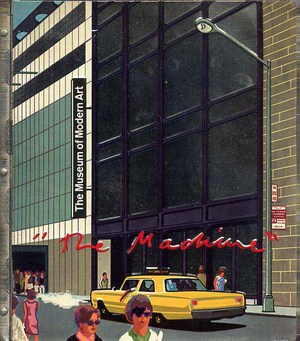
OK. Microworld. Holy crap, who made this thing? Owen Murphy Productions, who made several other films for Bell Labs over the years, including Incredible Machine (1968) which screened as part of the film program [PDF] at “The Machine As Seen At The End Of The Mechanical Age,” Pontus Hulten’s 1968 exhibit at The Museum of Modern Art. [that’s the show with the exhibition catalogue with the crazy, stamped metal cover.] Owen Murphy probably needs his/their own retrospective, too.
[11/2011 UPDATE: Thanks to Robin Edgerton, who has been working on the AT&T film archive, for pointing out that the correct title was Incredible Machine, not The Machine, as MoMA’s press release had it. You can watch Incredible Machine online.]
That will give us a chance to appreciate the backlit photomurals
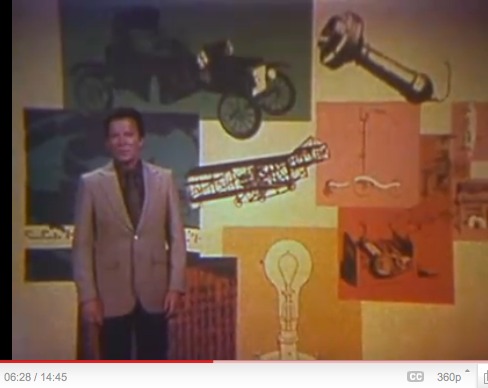
and the rather incredible prop circuitboard dioramas. [I left the timestamps in for easy reference.]

Shatner marvels for us at the minute intricacy of circuitboards reduced to eye-of-a-needle-sized microchips. Microchips which are apparently still designed in large-format, paper schematics.
Which are drawn. With a pen. By a [computer? punch card? stencil?] controlled mechanical printer.

Holy crap, people, this is a drawing.

Turned into a backlit transparency, but whatever. A DRAWING.
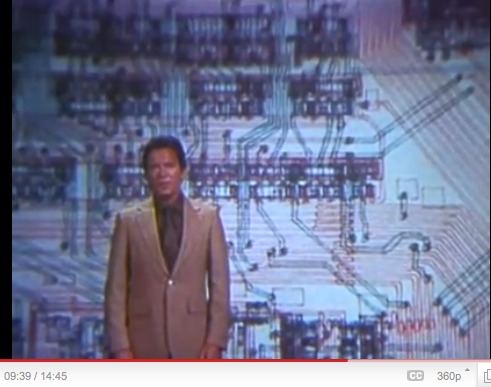
Jean Tinguely’s Metamatics drawing machines, we know. Olafur Eliasson’s studio folks set up that acoustic drawing machine at Tanya’s in 2008. [Wasn’t there also a thing with pulleys that drew on the wall? Who was that?]
Anyway, just saying, there are–or were–amazing drawing machines creating amazing, massive drawings, in the service of America’s most advanced scientists and engineers–who apparently didn’t bother keeping them? Where are they? What are/were they? Do any survive? What else could they be used for? I think I must find the answers to these questions.
UPDATE: ASKED AND BEGINNING TO BE ANSWERED
Thanks to Beau [aka @avianism], who points me to pen plotters and their adaptation and creative deployment, apparently in the last few years, by artists such as Douglas Repetto, whose drawing below, is part of the chiplotle group on flickr.

Chiplotle is a Python library created by Repetto and Victor Adan at the Columbia University Computer Music Center which allows you to code for and operate pen plotters from a laptop. The future of the past is here.
UPDATE UPDATE And whaddya know, via @johnpyper, there is a show of the Spalter Collection of computer code-generated art right now at the deCordova in Lincoln, MA, which includes, of course, Stan VanDerBeek, who worked on early animation and computer graphics languages at Bell Labs.
You Do Know Russell Mulcahy
When I saw it on Matt Connors’ blog, I realized I’ve never seen the 1985 music video for Culture Club’s “The War Song,” but it’s amazing for how familiar it feels.
Not the particular specter of war, of course; it’s worth remembering that the nuclear disaster we lived in fear of back then was quite different.
I mean the kind of dramatic, operatic style of the video itself. It FEELS like 80’s MTV. And no wonder. Turns out “The War Song” was directed by Russell Mulcahy, who is basically the Orson Welles and John Ford of MTV’s Golden Age. Not only did Mulcahy direct the first video ever shown on MTV, The Buggles’ “Video Killed The Radio Star.” He made two of Duran Duran’s three greatest videos–“Hungry Like The Wolf” and “Rio.” [The 1981 video “Girls on Film” was made by Godley & Creme.] Spandau Ballet’s “True.” Billy Joel’s “Allentown.” Kim Carnes’ “Bette Davis Eyes.” And on and on.
Holy smokes, in between Culture Club and Falco, he directed the original Highlander, too.
And Now For Something Completely Different
Enough Prince! Let’s talk about someone else! Richard Serra, for example.
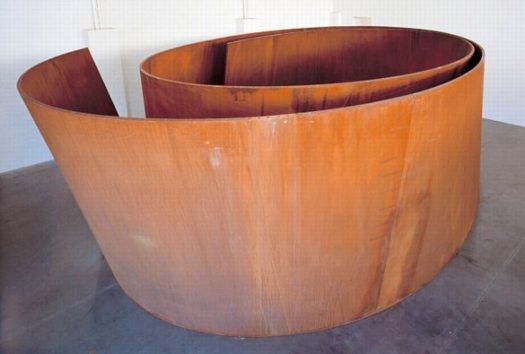
Bellamy, 2001, Richard Serra, image via gagosian.com
Did you know–I did not, which is why I am kind of fascinated to mention it here–that one of Richard Serra’s early torqued spiral sculptures, Bellamy, from 2001, was traded for…for three Richard Prince Canal Zone paintings?
Continue reading “And Now For Something Completely Different”
Canal Zone Richard Prince YES RASTA: Sample Spreads
Thanks for the support and feedback on the Canal Zone Richard Prince YES RASTA: Selected Court Documents &c., &c. book. [updated link info below]
Some folks who ordered the electronic version–the first to get the compilation in their hands, since the print editions take a few days to arrive–have emailed wondering where “the rest” of Richard Prince’s deposition transcript is, because there are gaps and missing pages.
That’s exactly right, and it’s why I decided to make this thing in the first place. As far as I can tell, the entire 378-page transcript of the 7-hour deposition was not entered into the court record, only the excerpts that pertained to quotes or points referenced in the two sides’ various legal motions. As I was reading those scattered snippets in various places in the court record, I realized it would be more useful to have a single compilation of all Prince’s testimony. And it’d be easier if it was in order. So I took apart the pdfs and sorted the pages, then interlaced the other exhibits [i.e., images from Cariou’s book and Prince’s show and catalogue] as they came up in the course of testimony.
Here are a couple of sample spreads taken from my original [sic, heh] pdf. There are about 250 of these transcript pages in total, four per printed/pdf page.
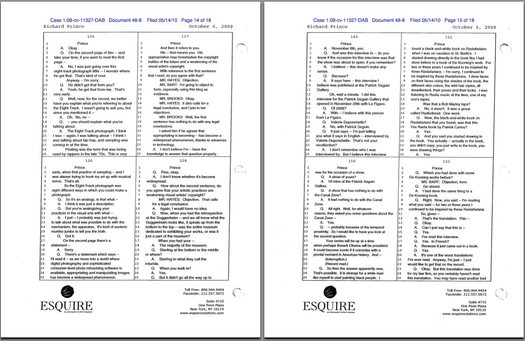
pp. 125-8, 149-152
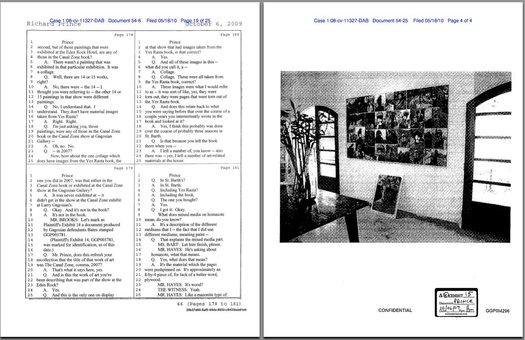
pp. 178-181 and Exhibit 15, installation shot at the Eden Rock Hotel, St. Barth’s
APR 2011 UPDATE: Here is the link to buy the new, expanded edition, which includes Prince’s entire deposition transcript–an additional 101 pages–plus other key legal documents. It’s a new printer, and the finish of the book is nicer, I think.
Canal Zone Richard Prince YES RASTA: The Book
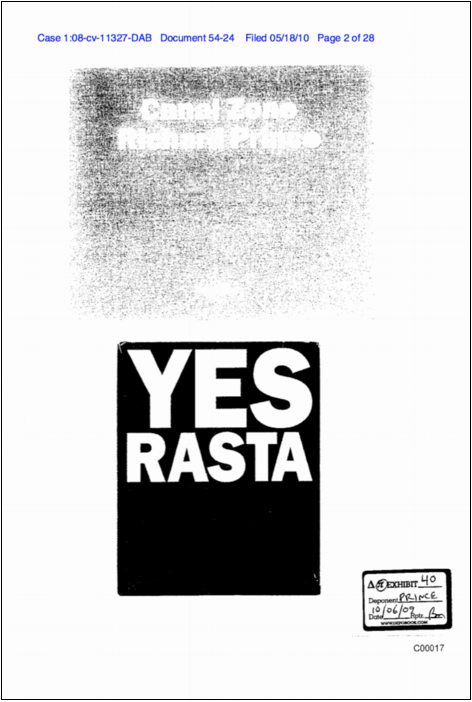
from greg.org: Canal Zone Richard Prince YES RASTA: Selected Court Documents, &c., &c. in
hardcover, 290pp. $24.99 [updated link info below]
Because really, why not?
It’s always bugged me when I read a news story about a legal case, or a scientific report, and there’s no link to the original source material. And since I’ve been quoting from them a lot lately, I have been fielding a lot of requests for copies of the court filings and transcripts in the Patrick Cariou vs. Richard Prince & Gagosian case.
It was yesterday afternoon, though, when I was sending my fourth email [or eighth, since the attachments are so big] that I realized Richard Prince’s deposition is not only the longest interview he’s ever given, it’s probably the longest interview he’ll ever give. [Go ahead, Hans Ulrich, you just try!]
I mean, seriously, the guy talked for seven hours. Under oath. In insane detail about his work, process, and ideas. Granted, he was being grilled by a guy whose art ignorance is only surpassed by his obvious contempt for Prince, a lawyer who can’t tell a photograph from a painting from a reproduction in a book. But still, he got Prince talking.
And Prince was surprisingly [to me, anyway] and admirably consistent and credible, at least in terms of his work. Yeah, it’s a nice bit of fact-checking trivia to strip away the coy mystery crap that surrounded his Guggenheim retrospective: Prince testified that he is Prince, and that he did live in the Panama Canal Zone, but only as a very young child.
But I found his explanation of his early formative inspirations, particularly Warhol and punk rock, to be both relevant and sincere. The deskilling argument that you could pick up a guitar for the first time, and by the end of the week, go up on stage and perform, with visceral effect, sounds real to me. It makes sense, at least in its own context [and in my own high school experience.]
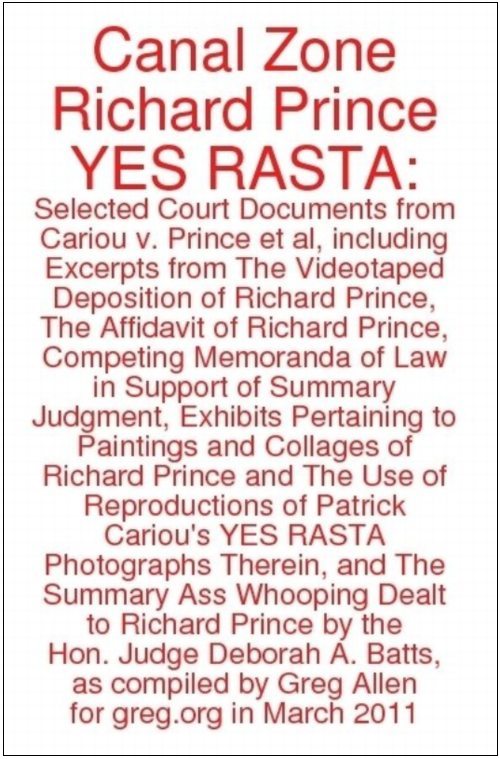
The cover of the paperback edition includes the full title. 290pp 376pp, $17.99
Anyway, Prince’s entire deposition transcript has not been released [update: it has now; see below], but a patchwork of 250 or so pages out of about 375 were attached as supporting documents to various filings and motions in the case. So I sifted through and pulled them all out, and then placed them in numerical order. There are a lot of gaps, of course, and legalistic joustings, but there’s a lot of information, too.
Combined with his 28-page affidavit, it really is the most extensive discussion of his work, practice and biography I’ve ever seen Prince make. The fact that it’s all coming out in the context of a copyright infringement lawsuit is really too perfect to pass up.
Into this I wove the major documents and exhibits Cariou’s lawyers discussed with Prince: all the Canal Zone series paintings; installation shots from the Eden Rock hotel in St. Barth’s; Prince’s “Eden Rock Pitch,” a rough movie treatment whose characters and story fed into the paintings; and Cariou’s extensive visual comparison of Prince’s Canal Zone paintings and the YES RASTA images that ended up in them.
And for good measure, I added both sides’ memoranda, where they make their fullest legal arguments for their fair use/transformative use and copyright infringement positions. And of course, I included Judge Batts’ ass-whooping of a ruling.
In all, 290 pages, all taken–appropriated, one could say–from the court record, but organized into a clearer, more readable format. And with a focus, not on an exhaustively documenting the case itself, but on Prince and his work.
If you were to download all of this material from pacer.gov, it’s run you upwards of $24 [$0.08/page]. And then you’d still have to sort it all out. For that money, I thought, you could have a nicely printed book. And so that’s what I did.
There are hardcover and paperback editions, and electronic copies, too, which I haven’t tested yet. I’m still tinkering with the cover design. Both versions are included inside the book, as frontispieces or title pages or whatever, but right now, the b/w cover cover is on the hardcover, and the red, made-with-Preview’s-default-annotation-settings version is on the softcover.
This is definitely an experiment, so any and all feedback is welcome. But if you’re looking for the perfect book to take to spring break, or to class up your summer share, then you have come to the right place. Enjoy!
Buy your own copy of Canal Zone Richard Prince YES RASTA: Selected Court Documents, &c., &c. in or in paperback [$17.99]. [createspace.com]
hardcover [$24.99]
APR 2011 UPDATE: OK, the response to this book really caught me off guard, so I’ve done some more work on it. The new, expanded edition now includes Prince’s entire deposition transcript, an additional 101 pages of testimony not previously released publicly, and several additional key legal documents from each side. In addition, while lulu.com was a quick and decent way to release a book almost instantly, I decided to switch to a higher quality printer for the new edition. The facsimile pages are a little smaller, which I’m still working on, but the quality of the book is noticeably higher. It now clocks in at 376 pages, for $17.99.
T-Shirt All T-Shirt No T-Shirt
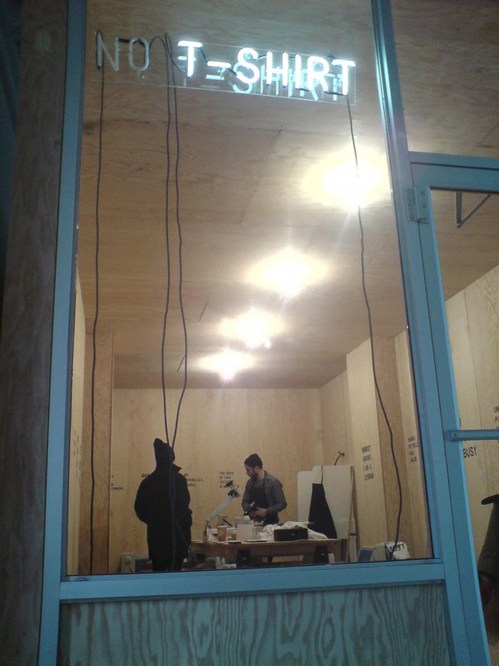
Has it already been two weeks since I went to Rirkrit’s show at Gavin Brown? Sheesh. Despite being there on a Thursday, there was no soup, but there were T-shirts. Nick was cranking them out, and I wanted to get one.
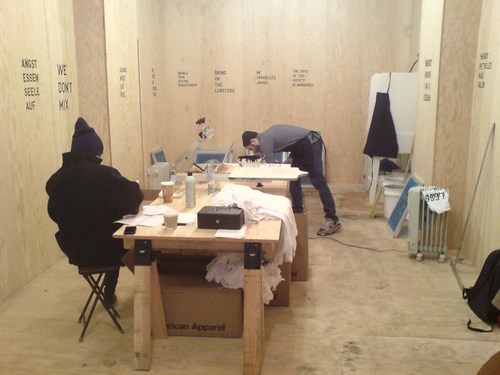
But I was stymied, couldn’t decide which of the 24 different sayings I wanted. And since they didn’t have my size anyway [XL, just one X, thank you], I knew I wasn’t ever going to wear it, so. So I got them all. Which Nick thought was amusing. Apparently hadn’t happened before. He gamely offered to crank them out while I talked to Gavin, but we decided it’d be easier to just pick them up later.
Or ship them, since he also still had a stack of orders from the opening. And then I went out of town, and I’m all, maybe I should send a couple of my goons over to the gallery and have them throw the shirts in the back of Gavin’s car and hotfoot them over to me.
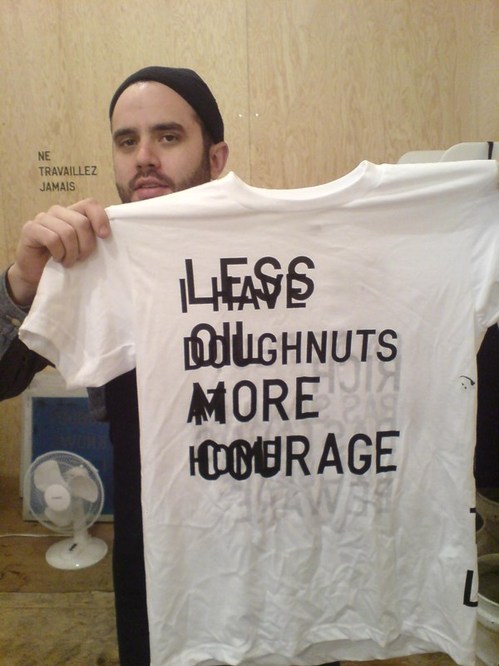
Maybe I’d tell them to only give the car back if they threw in a couple of the test shirts and rejects. Less Doughnuts More Courage. I Have Oil At Home.
Richard Prince Decision? You’re Soaking In It!
What with all this Prince in my head, I start seeing and reading and remembering things in relation to the Canal Zone case. For instance:
In conjuring up a meaning for Richard Prince’s Canal Zone work that fit the crime she was convicting him of, Judge Batts cited part of a 1978 essay on Appropriation Prince wrote, which he was asked about in his deposition. 1978!
I feel that I like to get as much fact into my work and reduce the amount of speculation. I believe there’s too much–I like an artwork where that when you see something, like a cowboy or a girlfriend, I mean these are, in fact, true.
Batts decided that this meant Prince appropriated Patrick Cariou’s photos because he was trying to convey the same “core truths” about Rastafarianism as Cariou. But it actually made me think of a quote from Greg Foster-Rice’s essay in his just-released anthology, Reframing the New Topographics, where he discussed the influential early 70s photography show in terms of systems theory, and in particular the system of photography itself:
Photographs, in other words, are distinct from other forms of representation in that their connoted messages are built upon a widely held belief in the medium’s denotative status as an almost perfect copy of the real.
I have to say, I really hated Canal Zone when I first saw it, but the more I study and think about it, I’m coming around. In one sense. Prince was making paintings about photography, and about the different expectations of truth and subjectivity, fact and fiction, each medium embodies. Which is nice.
Then there’s the kicker from Steven Stern’s review of Spiritual America: The Guggenheim Retrospective in Frieze:
Perhaps the key joke for the retrospective is one that appeared in several different paintings: ‘Man walking out of a house of questionable repute, muttered to himself, “Man, that’s what I call a business … you got it, you sell it, you still got it”.’ A museum is, after all, a house meant to settle questions of repute. And this particular museum exhibition was, among other things, a comment on Prince’s clearly impressive ‘business’. Like the one described in the joke, this industry depends on a seemingly magical economy: the slippery way that things that aren’t exactly objects – such as images and sex – get valued. Prince is a connoisseur of such economies. For better or worse, no matter how much he’s sold, he’s still got it.
That is just awesome.
And last but certainly not least, is Pablo Picasso, who Prince cited repeatedly as a model and an inspiration for his work. This quote is from an awesomely forthright talk Frances Stark gave at Mandrake Bar in LA in December 2009 as part of the Contra Mundum series. Ro/Lu, you’re off the hook, but the rest of you out there, are in deep trouble for not telling me about the published version of Contra Mundum I-VII. I’m the big man, need the info. Anyway, Picasso:
“But of what use is it to say what we do when everybody can see it if he wants to?”
The Five Most Ridiculous Things About The Richard Prince Copyright Decision
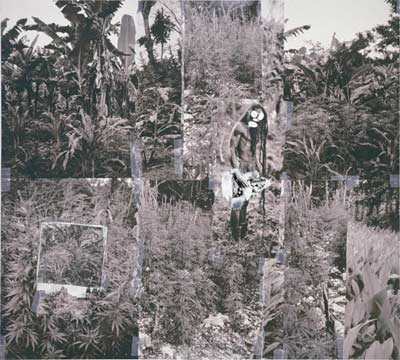
Paddy and her commenters have already done a pretty good job sorting through the decision in the Cariou vs. Prince & Gagosian case, and there are other folks out there with far more expertise and time than I who are also weighing in.
And while I still think this case is really troublesome for the whole fair use ecosystem as it applies to the art world–or more specifically, to artistic practice–that effect may not be lasting or widespread. Fair use and transformative work are still messy, ambiguous principles, almost by design, and artists are gonna do what artists have to do. And really, Judge Batts’ decision is so poorly constructed, and ignores or misconstrues so many basic facts of the case, that it can’t hold up to the inevitable, coming scrutiny, much less serve as any kind of practical impact going forward.
Still, it’s so awful, I can’t let it go without calling out a few of the most egregious passages, arguments, and errors. So here goes.
1) Cariou’s Photos Are Copyrighted. NO $#%ing DUH.
This is the first section of Judge Batts’ decision, and it has gotten a lot of media mention from the skimming crowd, even though it seems utterly and entirely irrelevant to anything at all. [p.10]:
Cariou’s ownership of a valid copyright in the Photos is undisputed. However, Defendants assert that Cariou’s Photos are mere compilations of facts concerning Rastafarians and the Jamaican landscape, arranged with minimum creativity in a manner typical of their genre, and that the Photos are therefore not protectable as a matter of law, despite Plaintiff’s extensive testimony about the creative choices he made in taking, processing, developing, and selecting them.
Unfortunately for Defendants, it has been a matter of settled law for well over one hundred years that creative photographs are worthy of copyright protection, even when they depict real people and natural environments.
I have looked, and I cannot find any documents where Defendants actually made this ridiculous claim that Cariou’s photos–arty, black & white, published in a book–are not copyrightable. It’s like the stupidest tumblr excuse ever [I found this image on the Internet, so it must be public domain!], not the argument the copyright lawyer for the most powerful art dealer in the world would make. Why is this even in here?

Look, the closest argument/evidence I could find is an exhibit [Doc. 61-1] rounding up dozens of Google Image searches for Rastas and Jamaican jungles and ganja tours, but that was to counter Cariou’s inference that the only way to take pictures of Rastas is to do what he did, and live with them for ten years. [Which, according to his deposition, it turns out he didn’t do, But whatever.]
Wow, is it really 12:30? I’ve gotta get some sleep. OK, we’re back. And what follows is, by any measure, too long.
Continue reading “The Five Most Ridiculous Things About The Richard Prince Copyright Decision”
Richard Prince’s Spiritual America
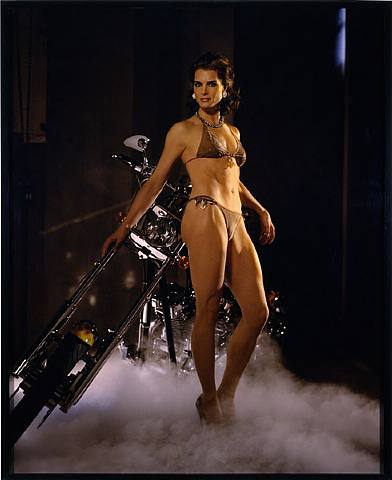
Holy smokes, Richard Prince, Patrick Cariou, Larry Gagosian, Judge Batts, Bob Marley, Richard Serra [! I know, right?], Brooke Shields, $18 million in artwork, the fate of appropriation, the implosion of the gallery system, copyright apocalypse, there’s so much mayhem to discuss, where to start?
Let me cut to the chase here, and focus on the single most important takeaway of the Cariou v. Prince & Gagosian Canal Zone case: he won’t be suing me.
During a deposition, Cariou’s lawyer Daniel Brooks asks Prince about his 2005 work Spiritual America IV [above], for which he appropriated Sante d’Orazio’s photo of an adult Brooke Shields re-staging the 1975 Gary Gross photo of a 10-year-old Shields which Prince rephotographed and showed in 1983, in a temporary storefront gallery he rented on the Lower East Side and called Spiritual America:
Looks Like I Picked The Wrong Week To Give Up Everything
Holy crap, I go away for a long weekend, and what happens?
The death toll in Japan doubles,
The number of meltdowns triples [or something],
We are at war in Libya,
The Death Star has the T-Mobile rebellion caught in a tractor beam,
and Richard Prince somehow lost his open & shut copyright infringement case.
I totally did not see that one coming.
UPDATE: OK, I’ve read through a bunch of the motions, affidavits, and depositions, and the decision [pdf here via aphotoeditor.com], which is basically a flabbergasting shitshow. I’ll probably write a bit more specifically later today, but if it stands, it would have major, sweeping, and stifling effects.
Not only would the current operating assumptions of fair use and transformative use be ratcheted way back, but the contemporary art world would be turned upside down. It would restrict both how artists appropriate, or even refer to, copyrighted work. And it would turn galleries into copyright police, with an affirmative responsibility to clear images, sources, and references for the work they show and sell.
If visual artists and the art market have been operating in some kind of an appropriation bubble, this decision would pop it. Artists would have to adopt the sampling, licensing, and rights clearing practices and infrastructures of the music industry, or the entertainment industry.
But the decision has some glaring omissions and relies rather heavily on almost-20-year-old textbooks and articles from law journals, while ignoring several highly relevant, recent decisions. The most notable ignored precedent is Blanch vs. Koons (2006), which happens to involve another Gagosian artist, and which seemed to set out a workable test of transformative use.
From reading the case materials, including Prince’s detailed descriptions of the making of each of the 29 Canal Zone paintings, it seems obvious to me that Prince and Gagosian were operating under the transformative work/fair use assumptions of Blanch, where changes in scale, medium, context, and color, along with process, editing, collaging, or other process-related elements, are used to identify a transformative work. Judge Batts doesn’t even address process, or any relevance of Blanch to the transformativeness; instead, she makes a blanket assumption that all 29 Prince paintings are infringing because they include Cariou’s Rasta images in some way. It’s really an eye-popping and untenable conclusion.
At the least, the fact that Gagosian the man and Gagosian the gallery were found equally liable for infringing, I am almost certain that this decision won’t go unchallenged. In a series of truly amazing statements, the most shocking is Batt’s cursory finding that Prince, Gagosian, and the gallery all acted in bad faith by not proactively pursuing permission from Cariou to use his images. In other words, operating under the assumption that an artist enjoys a fair use exemption to use or reference a copyrighted element, or that an artist is using copyrighted material in a transformative way, is, on its face, bad faith.
With upwards of $20 million in artwork and unspecified but certain punitive damages pertaining to bad faith actions on the line, there is NO way that Gagosian will let this decision stand.
On the other hand, the photographer crowd is jumping up and down with schadenfreudian glee. [Zaretsky’s rounding up more reactions at The Art Law Blog]
On Remembering The Great Kanto Earthquake
NYT Mag staffer Aaron Retica posted some childhood recollections from Akira Kurosawa of the horrible aftermath of the 1923 Kanto Earthquake, and the xenophobic hysteria that followed.
It makes me wonder, though, if Kurosawa ever spoke about his decision not to depict the earthquake in film.
Enzo Mari X IKEA + 6-Year-Old =

So I guess you could argue–and you wouldn’t be completely wrong–that no matter how many coats of hand-rubbed varnish it has, no matter how carefully calculated its design, or how flush its finishing nails, how stainless its many steel screws, a dining table which a six-year-old girl can snap apart like a pair of ramen truck chopsticks cannot, in the end, truly be considered a success.
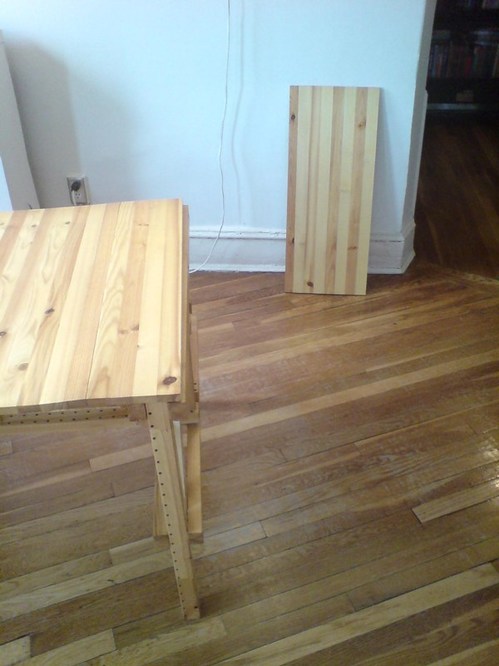
But anyway, it’s not worth arguing, because that’s what happened the other day. And it’s not important or even relevant to discuss exactly how it happened, or who did it. Because obviously, it’s my fault. In fact, if the Enzo Mari X IKEA autoprogettazione table survived a day in our house, it’s only because our family and regular visitors were living in fear, subjected to a constant, low-level psy ops campaign of tense looks and warnings, with suspected leaners getting regularly guided toward the table’s side seats and away from the cantilevered ends.

Because the top clearly broke on Ikea’s butt joint, and not my own is of little comfort; it broke where the fulcrum was–the base. I knew it would/could happen when I decided to make my table top from horizontally built up Ivar shelving instead of the other two options I had: 1) tracking down the original, 200cm long Ivar shelves that had just been discontinued when construction began, or 2) using the thick, pine slab head and footboards from a king-size Mandal bed. The former, I nixed because I decided that building a table from discontinued Ikea parts might hinder the vast revolution in autoprogettazione-inspired Ikea hacking that would surely follow the debut of my project. The latter, well, the bed frame came already finished, and that felt a little like cheating.

Now, of course, with a card-table sized dining table, I’m more than ready to compromise. But Ivar long shelves are still discontinued, and now, it turns out, so is the wood-intensive Mandal bed, which has been redesigned to use no headboard, or a weird, slatty thing you mount on the wall.
That means I’m going to need to re-create the table top as-is, and reinforce it underneath, and hope that it holds. Or I’ll replace it entirely, probably with some slabs of sick, slick, ultra-deluxe 500-year-old sinker pine from the bottom of some icy river somewhere. Either way, I’ll be back in the basement, varnishing something soon.
Previously: The making of an Ikea X Enzo Mari table, in many chapters
The Good Wife
You know, I tried. I really tried, but there just are not enough hours in the day. You can all take down David Colman’s John Currin & Rachel Feinstein Style section article yourselves. Lord knows everything but the headline–“Their Own Best Creations,” which at least gives a nod to the existence of artifice, spin, image management, the subjective construction of the self–is ripe for the kicking.
I will say that it’s the conveniently swattable straw men that bugged me the most. The specious [or is it?!] notion that “the art world” somehow punishes those artists who aspire to–or even approach–their collectors’ lifestyles. When, in fact, “the art world,” such as it is, is all but obsessed with art’s wave/particle-like duality, its near-magical power to transform culture into capital and vice versa.
The art world has been laboring mightily for decades to accommodate and cater to the needs, desires, lifestyles, and politics of wealth-flaunters, hyper-capitalists, and consumptionists of all kinds, and it pisses me off to see all that hard work go unrecognized by the Style section, of all sections!
The idea that Currin and Feinstein’s conservative political views somehow transgress anything but the feeblest cliche of liberal “art world” orthodoxies. I guess it’s the notion of “an” “art world” that’s so easily thwarted by John & Rachel’s unabashed fabulousness that really gets me.
Such an art world is a fairy tale. There are also more art worlds, and a far greater range of political views within them, than the Style section cares to acknowledge. I can think of a dozen conservatives–even some card-carrying neo-cons–who are prominent, active participants in New York City’s art scenes: artists, dealers, and curators, too, not just collectors or museum people. This heterogeneity is who “we” are, and to pretend otherwise, or to ignore these differences is willful or naive, or both.
Or maybe it’s that political differences in “the art world” have long been tolerated, negotiated, or if need be, consciously set aside or even suppressed in the interests of achieving an art-related goal. And really, are there any political chasms that can’t be bridged by Blanchette Rockefeller’s noble response to questions of whether his years as an enthusiastic Fascist activist might preclude Philip Johnson’s election as a MoMA trustee: “Every young man,” she reportedly said, “should be allowed to make one very large mistake.” I’m sure it works, try it at home!
As for Rachel’s work, and her career, and the inevitable comparison to her husband’s, how can it not be eclipsed? Is it apparently impossible to say that? But what is Rachel to do? Not show? Not make? Show under a pseudonym? Is it impossible to wonder if Rachel’s career differs from John’s because of her medium? Or her content? Or her concept? Or her gender? Was it “being that glamorous” that caused Feinstein to “take [her] eye off the ball” over the last few years, Jerry? Might having and raising three kids play a part? Maybe what Rachel’s career is really missing is a good wife.
Animal, Vegetable or Minimalism?

Have we considered Damien Hirst’s vitrine sculptures from the Wunderkammer perspective? Because the giant grab-bag auction at Pierre Berge & Associes in Brussels is stuffed [heh] with disturbing taxidermy, eerie medical/scientific specimens, and elaborate butterfly displays. Yes, that is a butterfly skull under glass. If you’re playing any Hirstian drinking games, you are now passed out on the floor.
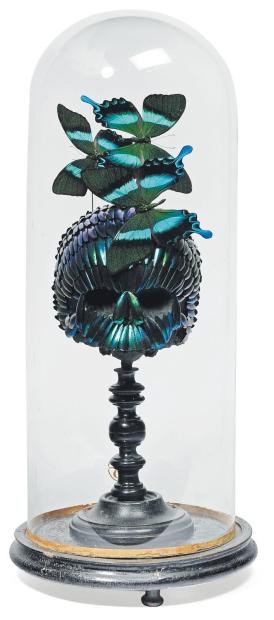
Or have we considered Olafur Eliasson’s art to be inhabiting a similar historical aesthetic trajectory?

Because seriously, put something in a bell jar, or on a tiny little display stand, and it gets immediately objectified and pretty damn near artified.

If not, then hop to it, Art History. Because right now, I’m too busy planning my show of found conceptualism and ur-Post-Minimalism:
Lot 451: a suite of 9 framed marble samples [est. EUR1300-1500]
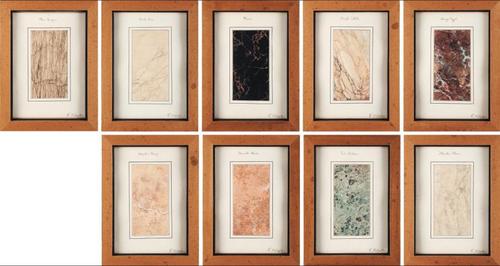
Lot 562: a cube-shaped Oryx-skin pouf [est. EUR 300-450]

I guess it’s really a pair: Lot 563: a cube-shaped boar-hide pouf [est. 300-450]
Lot 561: a large monochrome grid made of white wolf skin [est. EUR3000-5000]
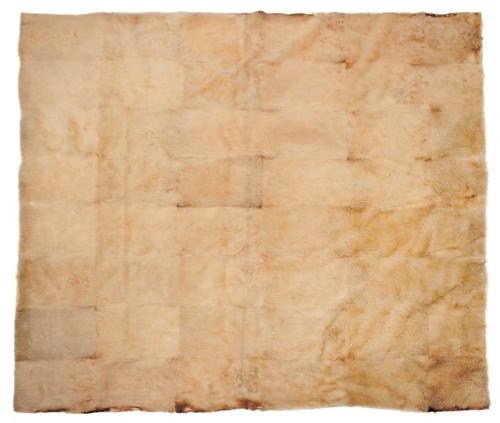
I guess it’s really a diptych: Lot 823: a large monochrome grid made of pink flamingo feathers [est. EUR 1500-2000]

And a couple for the back room:
This could be bigger: Lot 504: a sphere [23cm dia.] of polished thuya root burl [est. EUR 150-200]

And this could be a bit less Madison Avenue, but still: Lot 576: a plaque of caravan salt from Mali [est. EUR 1200-1500] [ref. flickr]
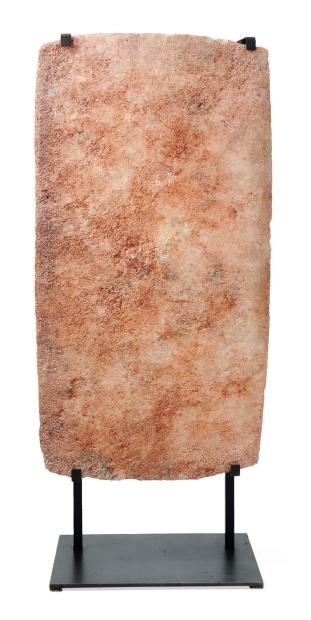
The Second Meeting With The First Meeting Of The Erik Satie Society
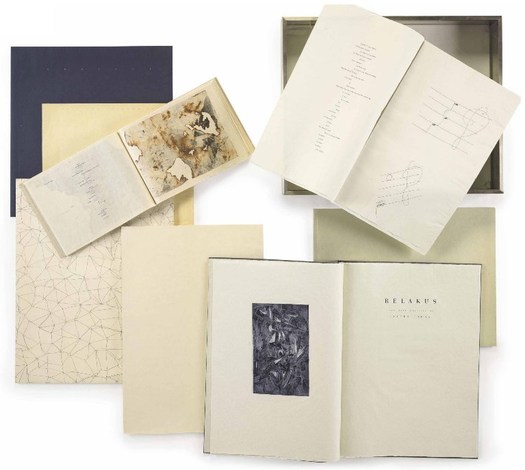
I totally remember seeing John Cage’s The First Meeting of the Erik Satie Society in the summer of 1994. An unbound version was on view at the Fuller Building on 57th Street. Susan Sheehan Gallery. It was on during Cage’s phenomenal retrospective/exhibition/performance, Rolywholyover: A Circus, at the Guggenheim SoHo. [I followed that show around the country like a Phish head, from MoCA, to the Menil, the Guggenheim, to the Philadelphia Museum. The PMA show coincided with my graduation from business school, and I had a couple of weeks where I was able to go every day, and watch the museum’s art handlers perform their I Ching-generated list of reinstallations. A formative experience, one of the absolutely greatest museum exhibitions ever, and probably the greatest catalogue I own. Reproductions of works, poems, and texts are packed loosely in a mirrored aluminum box. It’s a good segue to the Satie Society, and ‘m going to go pull it out right after I post this.]
Anyway. The Merce Cunningham Dance Company just sold a copy of The First Meeting of the Erik Satie Society at Christie’s last week, and I’m a little surprised at how vague the description is. Apparently, Cage’s box set of artist books, drawings and prints was supposed to be an edition of 18, or 9, but then the edition of 9 is described as unrealized, plus an “unbound” edition of 6… Sounds a bit of a mess.
The gist of the piece is that in 1992 Cage invited artists to a birthday party for the French composer who influenced him so profoundly, and the gifts are the artworks, which Cage combined with his own Satie-themed mesostic/acrostics based on writings he admired, too. It’s basically an exercise of homage, inspiration, collaboration, and transformation. Folks like Johns, Rauschenberg, Sol Lewitt and Robert Ryman contributed works, and Cage used texts from the likes of Joyce, Duchamp, Thoreau and McLuhan. The whole thing came in a steel-framed, broken-glass valise, a reference to Duchamp’s famously cracked Large Glass.
I’m going to guess that the version I saw was unbound, because the elements were mounted between freestanding glass panels around the gallery. So there’s one. How there could be ambiguity about work produced by this constellation of major artists just a few years ago–holy crap, almost 20 years ago–is a mystery to me.
Sale 2441, Lot 177: The First Meeting of the Erik Satie Society, by John Cage, est. $90-120,000, sold for $116,000 [christies.com]
Holy crap, $500? Rolywholyover: A Circus on Amazon [amazon]
Previously: Richter’s 4900 Colours and Cage’s Rolywholyover via sippey
